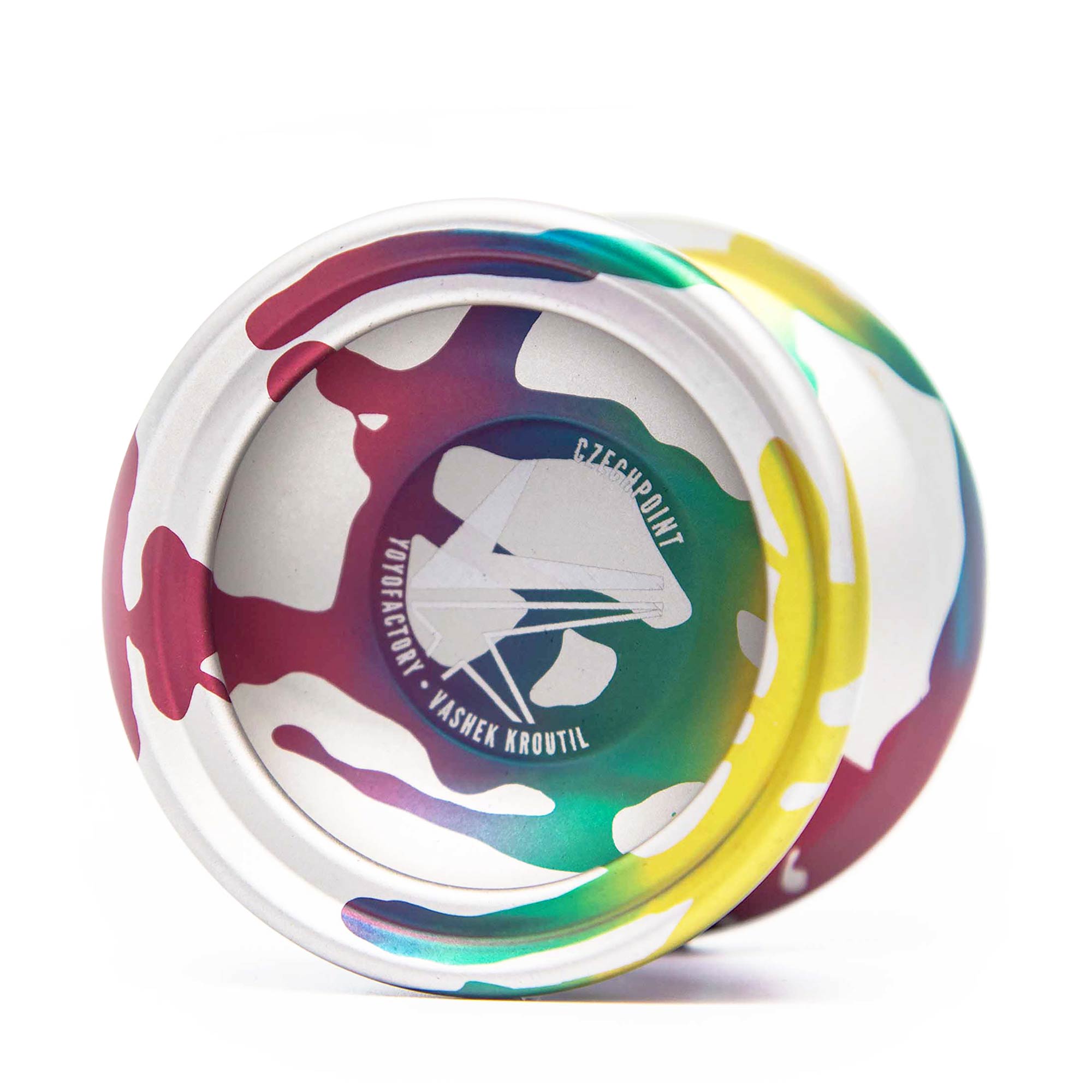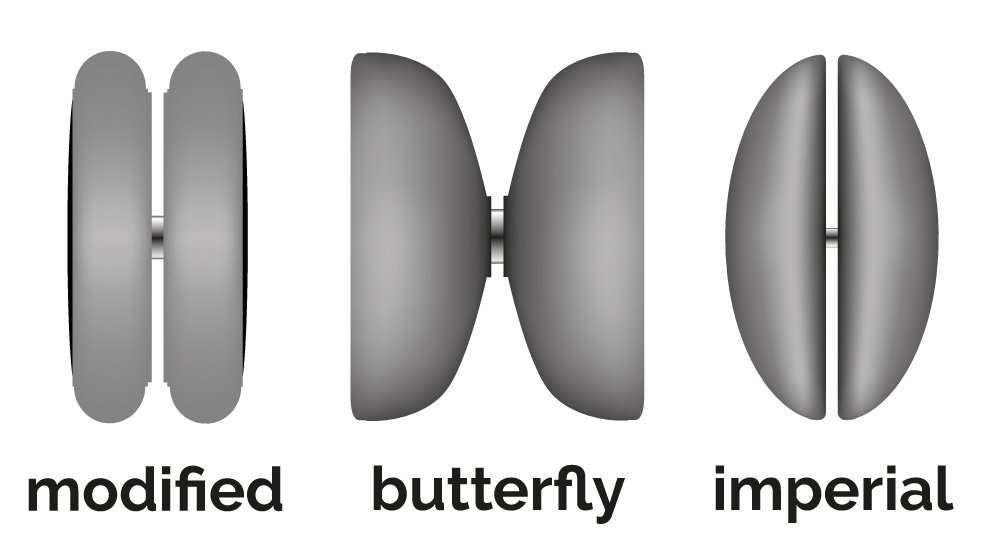
Yo-yo design and production has evolved so much from the Duncan Imperial, fixed axle design of 1954. With so many developments of shape, size, material and axle type, it’s very easy to get confused when searching for what would be best for your needs. We’re going to try and break down some of the major differences and terms in this article so the huge range of yo-yo’s available is a little easier to digest.
Yo-yo Shape
Knowing the profiles of yo-yo’s is essential in knowing which yo-yo will perform which tricks best and which shape will be best for your current trick set and newer tricks you are looking to learn. There are three major shapes available which you can see in the picture below.

Imperial
The imperial shape is what springs to mind when most people think of a yo-yo, when really, it’s probably the least used shape in the world currently. This shape is very good for learning how to control a basic yoyo and the basic tricks that come with that. Generally, they don’t sleep (spin at the bottom of the string) for a long time and are very difficult to perform string tricks with. They are however quite good for learning the basics of looping which are considered some of the most difficult tricks to perform, especially when using a yo-yo in both hands.
Modified
This shape was very common in the early ‘Playmaxx’ era and is the shape used with one of the greatest selling yo-yos of all time, the ProYo. Due to the slightly curved edge of the inner wall, more tricks were possible as friction was reduced on the string. This shape and slight variants of it are still used in contest level 2A yo-yos such as the Yoyofactory Loop 1080.
Butterfly
The most common shape of yo-yo in the world today, the butterfly shape has made the most complicated string tricks possible and changed the way yo-yo tricks are performed permanently. At the world yo-yo contest, four of the five styles are performed with this shape yo-yo and will be for years to come.
Axle Type and Gap Width
Early yo-yo’s featured a basic wooden axle but very quickly different materials where used as the tricks advanced, these axle are fixed in place and spin time is generally very low. Later came the ‘trans-axle’ system which features a loose fitting plastic sleeve around the axle enabling an even longer spin time, this system is still available in some yo-yo like the Henry’s Lizard.
One of the most important developments in yo-yo was in 1979, an American Dentist named Tom Kuhn created the SB-2, the first successful ball bearing axle yo-yo which changed the history as yo-yo forever. As more and more manufacturers where producing ball bearing axle yo-yos the tricks possible due to the extended spin time became more and more complicated.
This led to the development of the unresponsive yo-yo, which would require the ‘bind’ to return to the hand. This came around when the starburst response system on the SuperYo Renegade wore down and a tug would no longer return the yo-yo to the hand, yo-yo players used this to their advantage as it allowed more string layers to fit in the gap and even more complicated tricks were possible. This is considered the standard for high performance 1A yo-yos today.
Styles of Play
As the designs of yo-yos evolved, so did the styles of play. There are a huge amount of possibilities but there are mainly five, all of which are separate divisions at yo-yo contests around the world.
1A
1A or single A is the most competitive style of yo-yoing in the world today, it involves one long spinning, unresponsive yo-yo performing a variety of complex tricks.
YoYoFactory's Shutter yo-yo is an excellent choice for a string trick yoyo. The Shutter was used to win the 1A world title in 2014.
2A
In the opinion of most, 2A or double A is the hardest style to become proficient at. It is incredibly fast paced and the risk of error is extremely high. The style involves using two modified shape, responsive, bearing axle yo-yos to perform a variety of extremely complex looping tricks.
The Loop 1080 yo-yo from YoYoFactory is our pick for a looping yoyo. It won the world 2A title in both 2013 and 2015.
3A
Another two-handed style of play, this time performed with two long spinning, butterfly shape, unresponsive yo-yos, another very complicated, high risk style of play.
Our favourite 3A yoyo is the YoYoFactory Ex-Machina yo yo.
4A
4A or offstring is where the yo-yo is not attached to the string, it’s thrown and then caught on the string similar to a diabolo. This style opens up a huge amount of possibilities including running two yo-yos on the same string, this is known as ‘Soloham’ has grown in popularity in the last few years. The yo-yos used are generally a large butterfly shape to make them easier to catch.
The YoYoJam Fiesta Tres is our favourite off-string yo-yo. The Fiesta Tres is Bryan Figueroa’s pro model. Brian has won six US National 4A titles, more than anyone else in history.
5A
Freehand or 5A is where the string is no longer attached to the finger, it is instead attached to a counterweight, commonly a dice or a rubber ball. This style is very fast and allows switching hands between mid-trick and other aerial manoeuvres that would otherwise would not be possible. Normally a wider, unresponsive, butterfly yo-yo is used.
Best Yo-yos for Beginners
Choosing the first yo-yo for beginners can be very difficult with the huge amount of options available. Here’s a list of some of our favourite beginner's yo-yos:

If you’re looking for a traditional shaped yoyo to learn the basic throws and more classic tricks like ‘walk the dog’ and ‘rock the baby’ then this is perfect starting point. The Proyo features a wooden axle which makes these tricks much easier to perform but must be used with a cotton string as polyester will burn through.

The next step from a fixed axle yo-yo is a ball bearing axle, this allows the yo-yo to spin much longer and perform more complex tricks. The Butterfly XT is the latest take on the standard Butterfly featuring a ball bearing axle, it’s more than capable of performing all the basic, traditional tricks with the added perk of being able to perform basic string tricks. The profile of the yoyo makes it far easier to land on the string which in turn makes it far easier to progress and far more enjoyable to learn more complex tricks.

Yoyofactory produce arguably the best range of contest ready yo-yo’s, so when they produce something for beginners you know it’s going to be something special. The One comes as standard with two bearings, one thin bearing for basic responsive use and a wider one so you can start learning to play unresponsively, playing unresponsive unlocks a huge number of tricks which otherwise would not be possible and the Yoyofactory One helps make that transition as easy as possible.

Once you’ve learnt the basics of unresponsive play, you’ll want to move on to something more advanced. The Repay pro has all the features of a contest ready unresponsive yo-yo, apart from the price. It is without a doubt, the best plastic yoyo available in this price range.
Maintaining your Yo-Yo
Compared to other skill toys, yo-yos require a fair amount of maintenance to keep them on top form. Here’s some things to look out for.
String
First and foremost change your string regularly, it makes a huge difference. If your string is frayed or dirty, it’s time for a new one. There are many different types of string and they are all used for different yo-yos/styles. 100% cotton is the best string for fixed axles and come as standard in many Duncan yo-yos. 50/50 cotton/polyester are mainly used with responsive bearing yo-yos and favoured by 2A players. 100% polyester is the most popular string as it holds its tension better and is much better for slack tricks, it is not to be used on fixed axle yo-yos however as it will snap. Suitable for 1A, 3A, 4A and 5A.
String Tension
With all yo-yo’s you will find the string gets more or less twisted than it should, the most simple method to resolve this is to hold on to the yo-yo, take the string off of your finger and let it dangle and fix itself, or you can let the yo-yo hang and turn sideways until it stops and the string is put back in the right adjustment. These are the easiest two but there are more advanced methods.
Response
All yo-yos need a response system, this allows the yo-yo to return. Most modern yo-yos use a pad system; these are circular stickers that sit around the outside of the bearing. After a bit of use these pads will start to wear down and eventually need replacing.
So that about wraps it up for our guide to modern yo yo-ing. As ever, if you have any more questions please don't hesitate to contact us.




